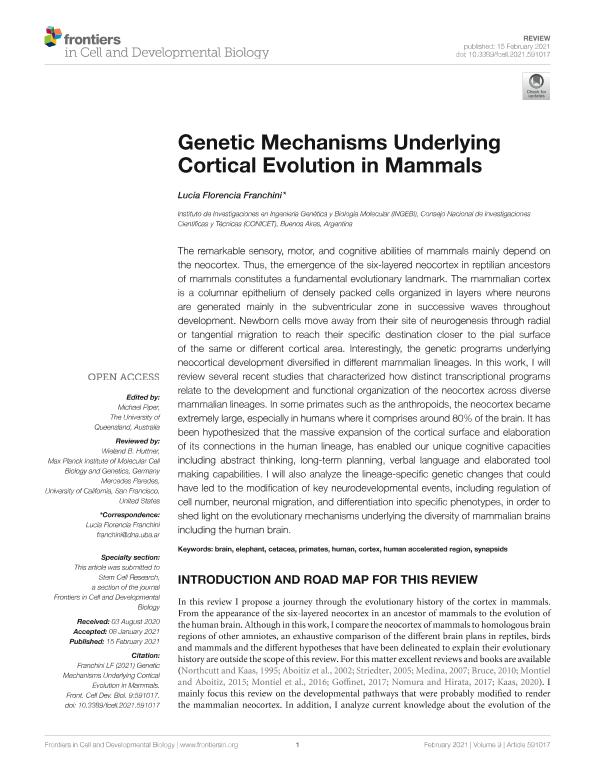Mostrar el registro sencillo del ítem
dc.contributor.author
Franchini, Lucia Florencia

dc.date.available
2022-07-28T17:53:42Z
dc.date.issued
2021-02
dc.identifier.citation
Franchini, Lucia Florencia; Genetic Mechanisms Underlying Cortical Evolution in Mammals; Frontiers Media; Frontiers in Cell and Developmental Biology; 9; 591017; 2-2021; 1-27
dc.identifier.uri
http://hdl.handle.net/11336/163440
dc.description.abstract
The remarkable sensory, motor, and cognitive abilities of mammals mainly depend on the neocortex. Thus, the emergence of the six-layered neocortex in reptilian ancestors of mammals constitutes a fundamental evolutionary landmark. The mammalian cortex is a columnar epithelium of densely packed cells organized in layers where neurons are generated mainly in the subventricular zone in successive waves throughout development. Newborn cells move away from their site of neurogenesis through radial or tangential migration to reach their specific destination closer to the pial surface of the same or different cortical area. Interestingly, the genetic programs underlying neocortical development diversified in different mammalian lineages. In this work, I will review several recent studies that characterized how distinct transcriptional programs relate to the development and functional organization of the neocortex across diverse mammalian lineages. In some primates such as the anthropoids, the neocortex became extremely large, especially in humans where it comprises around 80% of the brain. It has been hypothesized that the massive expansion of the cortical surface and elaboration of its connections in the human lineage, has enabled our unique cognitive capacities including abstract thinking, long-term planning, verbal language and elaborated tool making capabilities. I will also analyze the lineage-specific genetic changes that could have led to the modification of key neurodevelopmental events, including regulation of cell number, neuronal migration, and differentiation into specific phenotypes, in order to shed light on the evolutionary mechanisms underlying the diversity of mammalian brains including the human brain.
dc.format
application/pdf
dc.language.iso
eng
dc.publisher
Frontiers Media

dc.rights
info:eu-repo/semantics/openAccess
dc.rights.uri
https://creativecommons.org/licenses/by-nc-sa/2.5/ar/
dc.subject
BRAIN
dc.subject
CETACEA
dc.subject
CORTEX
dc.subject
ELEPHANT
dc.subject
HUMAN
dc.subject
HUMAN ACCELERATED REGION
dc.subject
PRIMATES
dc.subject
SYNAPSIDS
dc.subject.classification
Otras Ciencias Biológicas

dc.subject.classification
Ciencias Biológicas

dc.subject.classification
CIENCIAS NATURALES Y EXACTAS

dc.title
Genetic Mechanisms Underlying Cortical Evolution in Mammals
dc.type
info:eu-repo/semantics/article
dc.type
info:ar-repo/semantics/artículo
dc.type
info:eu-repo/semantics/publishedVersion
dc.date.updated
2022-05-06T16:05:58Z
dc.identifier.eissn
2296-634X
dc.journal.volume
9
dc.journal.number
591017
dc.journal.pagination
1-27
dc.journal.pais
Suiza

dc.description.fil
Fil: Franchini, Lucia Florencia. Consejo Nacional de Investigaciones Científicas y Técnicas. Instituto de Investigaciones en Ingeniería Genética y Biología Molecular "Dr. Héctor N. Torres"; Argentina
dc.journal.title
Frontiers in Cell and Developmental Biology
dc.relation.alternativeid
info:eu-repo/semantics/altIdentifier/doi/http://dx.doi.org/10.3389/fcell.2021.591017
dc.relation.alternativeid
info:eu-repo/semantics/altIdentifier/url/https://www.frontiersin.org/articles/10.3389/fcell.2021.591017/full
Archivos asociados
